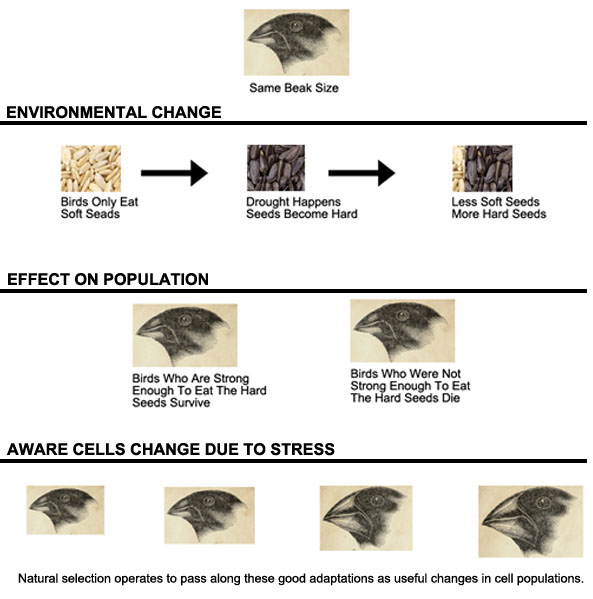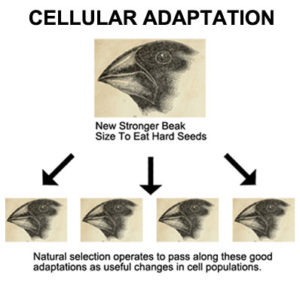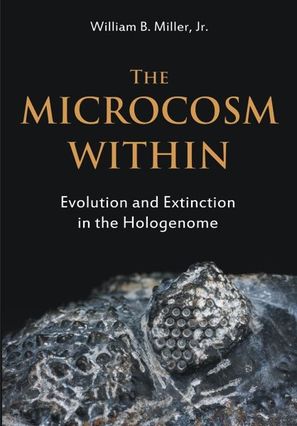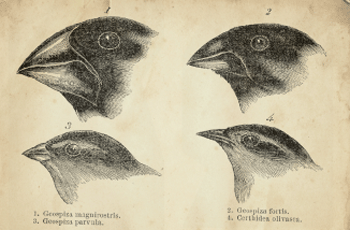 I had recently been asked to comment on a dialogue between two evolutionary biologists as they debated the role of natural selection in evolution. Both assumed that that there was no valid alternative. Neither seemed to grasp that there are actually are two differing conditions in which its influence might be fully evaluated.
I had recently been asked to comment on a dialogue between two evolutionary biologists as they debated the role of natural selection in evolution. Both assumed that that there was no valid alternative. Neither seemed to grasp that there are actually are two differing conditions in which its influence might be fully evaluated.
Any assessment of the importance of natural selection must take into account both of these separable components.
What Has Been Believed About Evolution Until Now?
Several generations of scientists have believed that Natural Selection can be fairly well summarized as a narrative of “survival of the fittest“. In modern terms, different variations of organisms arise through tiny random genetic mutations. Necessarily, the process is very gradual, its effects are cumulative and the relevant action is on the entire organism that can be seen with your eyes.
So What’s Wrong With The Current Theory Of Natural Selection?
To be a satisfactory explanatory theory, natural selection must dominate two different biological processes. One of these is concerned with how complex novelties develop to account for the origin of species through reproductive isolation. The other relates to the means by which any species, once established, might thrive and continually adjust within a highly competitive environmental landscape. In any examining the former case, that is, considering natural selection as an agency of novelty or speciation, natural selection that is defined by fitness becomes a tautology or circular argument.
Darwin describes natural selection as the “preservation of favorable variations and the rejection of injurious variations…” The favorable ones then enhance reproductive success. Yet, the definition of fitness is, in turn, exactly defined as reproductive success. What is preserved and reproduces best is always defined as ‘fit’ and ‘fitness’ is always defined by reproductive success. Do you see the circular argument here? By this linkage, ‘preservation’ and ‘favorable ‘ and ‘reproductive success’ are identities by mutual definition and yield a self-fulfilling circle. So, as a rational, there is nothing here that explains how novelty arises.
Natural Selection Relates To Breeding
When it comes to understanding the maintenance of an established species, natural selection is not circular reasoning. It is an explanatory mechanism for observations that relate to breeding. For example, with Darwin’s finches, it is true that certain beak shapes can cope with some nuts better than other beak shapes. Therefore, a linkage between preferential survival frequencies and one type of phenotype, like a beak shape, can be assessed as particularly suited for the environment in which that bird must exist. As a filter of existing traits that can come out of a preexisting genetic code, natural selection offers descriptive opportunities. It is important to remember that selection does not produce the variation of beak shapes. That has to come first from something else. To modern Darwinists, this occurs through random genetic mutations. The exact problem is that although random genetic variation in a genome does occur, there is nowhere near enough to account for evolution. We have learned that there simply are too robust repair mechanisms to account for evolutionary change as a primary driver. So, no matter how appealing the theory, our actual observations indicate that is just is not so. Consequently, the current theory of natural selection has significant limitations in explaining a large aspect of evolutionary development.
What Can Be Offered As An Alternative Theory To Natural Selection Then?
In our present era, there is an alternative approach to evolutionary development that has much greater explanatory power. This is new path is termed Cognition-Based Evolution (CBE). When compared to Darwinism, this new narrative starts from a new place, uses a different mechanism to account for evolutionary change and novelty, and offers a new evolutionary endpoint that conforms to our contemporary understanding of complex organisms.
What Is The New Starting Point?
Modern research has shown that all living things and all cells are cognitive. That means that they can communicate, are aware of their environment, and can solve very basic problems at their scale. This means that cells are aware of environment shifts.
How Can Evolution Proceed Based On This New Starting Point?
Since all cells are aware of their surroundings and want to maintain their own optimum state, they cooperate and collaborate with other to achieve it. This is what the cells in our bodies are doing all the time. Even though we may regard cells as simple, this process is highly sophisticated. In fact, it is complex enough to be considered a form natural cellular engineering that shares commonalities with our own human forms of engineering. Through this means that requires mutual collaboration and competition, cells build vast cellular ecologies. This is what makes up all the tissues in our bodies.
Cells go about this activity in just the same way that humans collaborate and compete to build cities. It is obvious to us that there is nothing about a human being that looks like a city. For cells, it is the same. The cellular ecologies that make up our forms are their expression of building a city, only, instead of iron, or steel, or wood, they use biological materials. The purpose of all this action is to continuously adjust to environmental stresses and survive. In a nutshell, this is the way that cells solve problems.
Cellular Adaptation
If their attempt to solve problems as an ecological team is a failure, then it is abandoned at the cellular level. Natural selection operates to pass along these good adaptations as useful changes in cell populations. The difference from Darwinism is stark. Evolution proceeds by bubbling up from the actions of cells to solve their environmental problems and not from random genetic variations. When they produce a solution or its variations, natural selection filters out those results. Only the good solutions survive. Since all these cells are acting to solve problems, the solutions are not random.
What Is That Different Endpoint?
Important research in the last few years has revealed a startling reality about ourselves. Although we think of ourselves as a singular organism, nature sees us very differently. Our actual composition is a complex mixture of life that includes a vast array of microbes and our own personal cells. These microbial partners outnumber our own personals cells by a factor of 10 to 1.
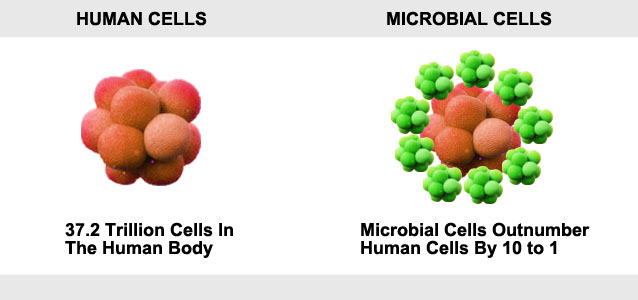
Microbial Cells Outnumber Human Cells 10 to 1
This may be hard to accept, since we feel like we are a single being, but that is just an illusion, a trick that biology plays on us. And these microbes, are not just hanger’s on. Instead, our partnership with them forms a vital aspect of our nutrition, immune systems, metabolism, nervous system and development. Together, these microbes and our own cells constitute the partnerships that make the ecological teams. And it is those teams, in huge numbers, all linked together that make us what we are. This combined organism is called a holobiont or hologenome, and every organism you can see with your eyes is just such a thing. There are no exceptions.
Conclusion: A Better Solution To The Perplexities Of Evolutionary Development
New research is revealing an enormous amount of information that permits a conclusive alternative theory to Darwinism. Compared to decades ago, we now know that all cells and living things are cognitive. All living things use information and communicate it to thrive and survive. They exchange this information to solve problems caused by an environment that always has dynamic shifts. The most effective manner in which our personal cells and our companion microbes can solve these environmental problems is by joining together in vast mixed cellular ecologies. When linked together, these ecologies collaborate, cooperate and compete to produce results that produce that organisms that we can see with our eyes. We, and “endless forms most beautiful” are its yield. Have questions or comments? Please leave them below.
THE BOOK
The Microcosm Within offers intriguing and profound answers by exploring our extraordinary world of cellular consciousness, connections and collaboration. Current research has unexpectedly revealed that all cells and microbes have elemental cognition and a previously unappreciated capacity for discrimination and awareness. From these faculties, cooperative natural genetic engineering is enabled; and it is from this starting point that biological complexity evolves. The Microcosm Within illuminates how immunological factors dominate evolution and extinction. Biology and evolutionary theory will never be the same.
 The Microcosm Within | Modern Theory of Evolution |
The Microcosm Within | Modern Theory of Evolution |
